Abstract
Environmentally friendly coated urea prepared using a waterborne polymer coating material is essential for promoting green and sustainable practices in modern agriculture. However, significant efforts are still urgently needed to address the undesirable properties of waterborne polymer coatings, i.e., poor hydrophobic properties and numerous micropores. Herein, dual nano-SiO2 and siloxane-modified waterborne-polymer-coated urea was successfully developed. The characteristics of waterborne-polymer-coated urea before and after modification were compared. The results demonstrate that nano-SiO2 and siloxane modification improved the hydrophobicity (water absorption decreased from 119.86% to 46.35%) and mechanical strength (tensile strength increased from 21.09 to 31.29 MPa, and the elongation at break exhibited an increase of 22.42%) of the waterborne polymer coatings. Furthermore, the –OH number of the modified coatings was decreased, while the coating surface formed a nano-scale rough structure, prolonging the nitrogen (N)-controlled release period from 7 to 28 days. Overall, the proposed novel dual-modification technique utilizing waterborne polymer coatings highlights the significant potential of eco-friendly coated urea with renewable coatings in modern agriculture.
1. Introduction
To meet the increasing demand for food and various green crops, enhancing crop yields via multiple methods is essential [1]. Chemical fertilizer is an alternative method used to enhance critical nutrients for crop growth [2,3]. However, low fertilizer use efficiency (FUE) (30–50%) leads to significant environmental pollution [4,5]. Slow-release fertilizers (SRFs) can improve nutrient uptake by crops and enhance FUE while reducing the environmental hazards resulting from fertilization [6]. Findings from previous work have demonstrated that the utilization of SRFs could improve the FUE by 60–80% [7]. Therefore, significant efforts have been dedicated to developing SRFs.
The fertilizer release properties of SRFs have been found to be closely linked to the structure and characteristics of coatings [8,9]. Recently, polyurethane coatings have been widely used owing to their adjustable structures. However, their nonrenewable and nonbiodegradable characteristics, along with their environmental risks to soil, have limited their commercial application [10,11]. Hence, the development of sustainable and environmentally friendly polymer coatings has attracted increasing attention. Sustainable and environmentally friendly coatings, such as chitosan (CS) [12], cellulose, polyvinyl alcohol (PVA), and starch [1,13], have provided a viable approach to developing conventional coatings because of their advantageous physicochemical properties, including non-toxicity, biodegradability in soil, and excellent soil water retention capacity, which are particularly useful in SRF production [14,15]. Among these sustainable and environmentally friendly coatings, PVA has been thoroughly investigated as a film-forming agent for coated urea due to its excellent film-forming ability and advantageous swelling properties [16].
However, the N controlled-release period offered by PVA-coated urea is quite limited and typically lasts only a few days, owing to its extreme water solubility and strong tendency to absorb water [17]. Hence, key methods such as blending, copolymerization, and chemical modification offer effective means to enhance the water tolerance of PVA coatings. For instance, cross-linking PVA via glutaraldehyde can create a high-density architecture that augments PVA’s water tolerance [18]. Blending CS with PVA is considered to render excellent mechanical and chemical properties due to the specific intermolecular interactions between the hydrophilic groups of PVA (–OH) and those of CS (–OH and –NH) [19], though this method is far from being applicable for the long growing periods of crops.
The development of superhydrophobic technology provides a robust strategy to boost hydrophobicity and overcome the poor fertilizer release properties of sustainable and environmentally friendly coatings [20]. Superhydrophobic coatings are inspired by the micro- and nanoscale structural characteristics of natural superhydrophobic surfaces, such as the surface of lotus leaves [21]. For example, Xie et al. [22] developed superhydrophobic bio-based polyurethane-coated urea using fluoroalkyl silane and nanosilica, and its nitrogen (N) release longevity exhibited twofold improvement. Chen et al. [23] fabricated a novel waterborne hydrophobic polymer coating modified with nano-SiO2 and 1H,1H,2H,2H-perfluorooctyltriethoxysilane (FAS), and its water contact angle increased from 33.3° to 120.9°. Nevertheless, the self-assembly method is relatively complex, and industrial production is difficult to achieve. Although numerous bioinspired superhydrophobic coatings have been developed, sustainable and environmentally friendly coatings with superhydrophobic surfaces fabricated using a convenient method still warrant further investigation.
Therefore, this study aimed to design a novel slow-release coated urea employing sustainable, eco-friendly polymer coatings. First, PVA, CS, polyvinylpyrrolidone (PVP), and starch were used to fabricate a sustainable and eco-friendly coating film, followed by straightforward modification with nano-SiO2 and siloxane to enhance its hydrophobicity. The effects of the concentration of waterborne polymer coatings and the doses of siloxane and nano-SiO2 on the sustainable and eco-friendly coating film’s properties were evaluated. The formation mechanisms and N-release profiles in soil were also investigated.
2. Materials and Methods
2.1. Materials
Starch, PVP, CS, and PVA were purchased from Sinopharm Chemical Reagent Co., Ltd. (Shanghai, China). Nano-SiO2 and siloxane were provided by Aladdin Biochemical Technology Co., Ltd. (Shanghai, China). All chemical reagents used in this work were analytical-grade.
2.2. Formulation and Preparation of Hydrophobic Waterborne Coating Films
2.2.1. Formulation and Preparation of Waterborne Coating Films
Waterborne coating films were fabricated by mixing distilled water and PVA in a 500 mL round-bottom flask with three necks. The mechanical stirring rate was 200 r/min. The solution was heated by gradually increasing the temperature to 90 °C over approximately 1.5 h to ensure the complete dissolution of PVA, and then, the temperature was dropped to 60 °C. PVP, CS, starch, and glutaraldehyde were added to the PVA solution and continuously stirred for 1 h to form a well-homogenized waterborne coating film. The doses of PVA, PVP, CS, and starch used were decided via an orthogonal experiment including four factors and three levels. The experimental design is shown in Table 1.

Table 1.
Factors and levels of the orthogonal experiment.
2.2.2. Formulation and Preparation of Hydrophobic Waterborne Polymer Films
First, 30 g of waterborne polymer coating material was placed in a 50 mL glass beaker, and certain doses (0, 0.5%, 1.0%, 1.5%, and 2.0%) of SiO2 and siloxanes were added for premixing with an ultrasonic numerical control cleaner at 60 °C for 1 h. Thus, the hydrophobic waterborne polymer was obtained. Finally, the coating material was sprayed onto glass plates using a high-pressure spray gun, and then, the hydrophobic waterborne polymer films were obtained.
2.3. Fabrication of Hydrophobic-Waterborne-Polymer-Coated Urea (SWCU)
The optimal ratio of the hydrophobic waterborne polymer coating material was selected for the preparation of coated urea. Hydrophobic-waterborne-polymer-coated urea was fabricated as follows. First, we screened urea particles with a diameter of 2–3 mm and then removed the urea particles with surface defects before coating. Second, the sieved urea granules (1 kg) were transferred to a rotary coating machine (WKY-300D, Weifang North Pharmaceutical Equipment Manufacturing Co., Ltd., Weifang, China) and heat-primed at 70 °C for 10 min. Finally, the hydrophobic waterborne polymer coating material was sprayed onto the surface of the urea granules using a high-pressure spray gun (DC-819, Coviler (China) Co., Ltd., Shanghai, China) to form a coating thickness of 7%. Thus, hydrophobic-waterborne-polymer-coated urea (SWCU) was obtained. Similarly, the waterborne-polymer-coated urea (WCU) and nanomodified waterborne-polymer-coated urea (NWCU) were fabricated using the same methods. The total N content of coated urea was measured using Kieldahl Azotometer (Qingdao Jingcheng Instrument Co., Ltd., Qingdao, China).
2.4. Determination of Water Absorbency and Porosity
2.4.1. Determination of Water Absorption
The waterborne polymer coating was cut into 3.0 cm × 3.0 cm pieces and then dried at 60 °C and weighed (M1); then, the waterborne polymer coatings were submerged in a beaker (50 mL) filled with distilled water for 3 h at ambient temperature. Finally, the saturated coating film (M2) was weighed. Water absorption was determined via the following formula:
Water absorption = (M2 − M1)/M1 × 100%.
2.4.2. Determination of Porosity
The coating film (1.0 cm × 1.0 cm) was dried to a constant weight, and then, its density was calculated. Thereafter, the coating film was immersed in distilled water. Once saturated, the coating film was removed, and then weighed. The porosity of the waterborne polymer coating was determined via the following formula:
where ε denotes the porosity of the waterborne polymer coating, WW denotes the wet weight, Wd denotes the dry weight, ρw is the water density (g/cm3), and pp is the density of the waterborne polymer coating.
2.5. Characterization
The bonds introduced by cross-linking the waterborne polymer coatings, siloxane and nano-SiO2, were measured using a Nicolet iS50 Fourier-transform infrared (FTIR) spectrometer (Thermo Fisher Scientific, Inc.,Waltham, MA, USA). The microstructure of the waterborne polymer coating films and hydrophobic waterborne polymer coating films were determined with a scanning electron microscopy (SEM) (Regulus 8100, Hitachi, Ltd., Tokyo, Japan). Surface elemental distribution was detected using an X-ray photoelectron spectroscopy (XPS) (Thermo Fisher Scientific, Inc., Waltham, MA, USA). Thermal behavior was investigated using a simultaneous thermal analyzer (TA Instruments, New Castle, DE, USA). The hydrophobic capacity of the waterborne polymer coatings was measured with an Easy Drop contact angle meter (Krüss Scientific, Hamburg, Germany). The tensile strength and elongation at break of the waterborne polymer coatings were determined with a universal testing machine.
2.6. N-Release Characteristics of Hydrophobic WCU
The N-release profiles of WCU, NWCU, and SWCU in soil were determined. Firstly, air-dried soil was sieved (60-mesh), homogenized, and then hydrated to 40%, 60%, and 80% field capacity. Secondly, coated urea (2.0 g) was sealed within 200-mesh nylon bags. Three such nylon bags were then placed in three separate plastic bags containing 50 g of soil with 40%, 60%, or 80% field capacity. Finally, the samples were incubated at 25 °C. With the incubation time increased to 1, 3, 5, 7, 10, 14, 21, 28, and 35 days, the three experimental samples were taken out from the plastic bags. Then, the remaining coated urea was dried in an oven, and the N content was determined via a Kieldahl Azotometer (Qingdao Jingcheng Instrument Co., Ltd., Qingdao, China).
3. Results and Discussion
3.1. Water Absorption
The water absorption of the waterborne polymer coating films was significantly affected by the concentrations of PVA, PVP, CS, and starch (Table 2). With the raw material ratio changing, the WA of the waterborne polymer coating films ranged from 119.86% to 186.35%. When the concentrations of PVA, PVP, CS, and starch were 4%, 3%, 3%, and 3% (W3 treatment), respectively, water absorption was the lowest, being 19.96–35.68% lower than the values obtained under other W treatments. Previous studies have shown that a coating film with lower water absorption shows a better controlled-release performance [24]. To further improve the N-release properties of the waterborne polymer coatings, nano-SiO2 and siloxane were employed to modify the W3 polymer coatings. Figure 1 illustrates the water absorption behavior of the hydrophobic waterborne polymer films with different nano-SiO2 and siloxane contents over a period of 3 h. With the content of nano-SiO2 increasing from 0.0% to 2.0%, water absorption significantly decreased from 119.86% to 49.60%, a decrease of 58.62%. With the addition of siloxane, water absorption further decreased. When the contents of nano-SiO2 and siloxane were 2.0% and 1.5%, respectively, the water absorption of hydrophobic waterborne polymer films decreased to 46.35%, which was 61.33% lower than that achieved under W3 treatment. The reduction in water absorption may be attributed to two main factors. First, if the waterborne polymer forms a network structure via polymer chain reactions with nano-SiO2 and the excess −OH groups are bonded together, then the number of hydrophilic groups would decrease [23]. Second, the addition of siloxane may promote the cross-linking of the waterborne polymer coating, and the hydrophobic nature of the siloxane component may further decrease water absorption [4].

Table 2.
Water absorption values of the waterborne polymer coating films.
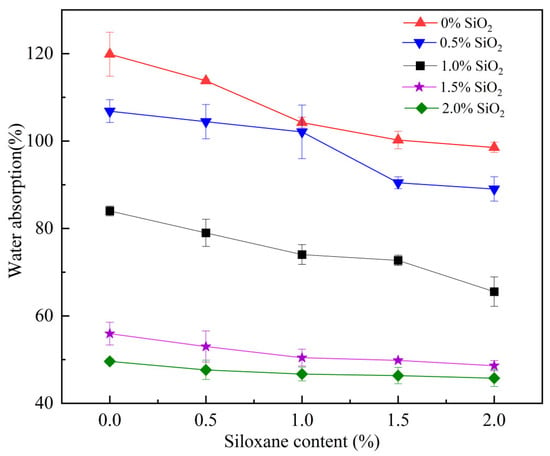
Figure 1.
Water absorption of the hydrophobic waterborne polymer coatings.
3.2. Porosity
Coating films with higher porosity may lead to a higher absorption of water. Moreover, with the absorption of water, the coating films undergo swelling, and then, intermolecular spacing increases [4]. These factors might enhance the transmembrane transport of N within the coating film, leading to a poorer N-release characteristic. Therefore, the water absorption rate and porosity of the waterborne polymer coatings play a key role in determining the performance of the slow-release waterborne-polymer-coated urea. Figure 2 shows that siloxane and nano-SiO2 exert a significant effect on the porosity of the hydrophobic waterborne coating films. The coating film without siloxane and nano-SiO2 exhibited higher porosity (58.91%). With the addition of nano-SiO2, the porosity of the hydrophobic waterborne coating film significantly decreased. When the content of nano-SiO2 increased to 2%, the porosity of the hydrophobic waterborne coating film decreased to 45.89%, which was 22.10% lower than that for treatments without siloxane and nano-SiO2. Furthermore, with the content of siloxane increasing from 0% to 1.5%, the porosity of the hydrophobic waterborne coating film significantly decreased. However, with the content of siloxane further increasing, the porosity remained almost unchanged.
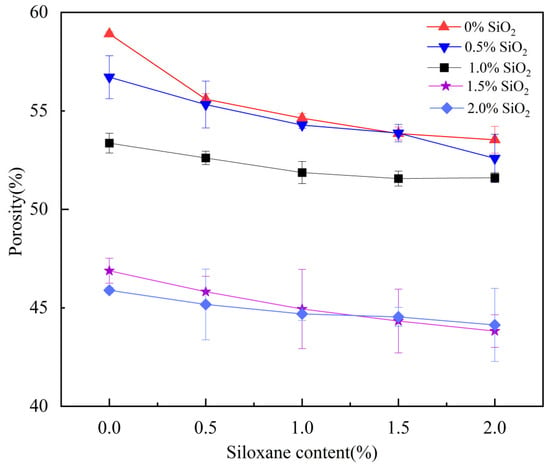
Figure 2.
Porosity of the hydrophobic waterborne polymer coatings.
3.3. Mechanical Strength
The mechanical strength of waterborne coatings is a critical parameter in evaluating coating performance [25]; therefore, the influence of nano-SiO2 and siloxane on the mechanical properties of the waterborne coatings was investigated. As shown in Figure 3, after nanomodification, the tensile strength and elongation at break of NW coatings significantly improved to 26.54 MPa and 56.75%, suggesting a 25.84% and 17.78% increase, respectively, compared to those for the W3 treatment. This phenomenon may be attributed to the enhanced cross-linking density between the waterborne polymer and the inorganic networks. Furthermore, the nanoparticles were confirmed to be uniformly distributed throughout the polymer matrix, functioning as effective reinforcing fillers [26,27]. With the addition of siloxane, the tensile strength and elongation at break further improved, probably owing to the increase in hydrogen bonding and cross-linking [25,28]. These results indicate that the addition of nano-SiO2 and siloxane makes the waterborne polymer coatings stronger.
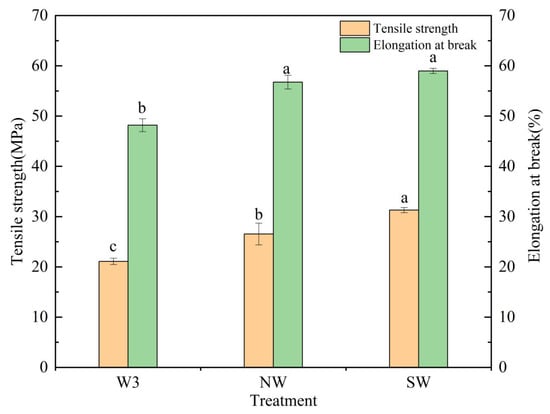
Figure 3.
Tensile strength and elongation at break of the hydrophobic waterborne coatings. Note: Different letters indicate a significant difference among treatments (p < 0.05).
3.4. FT-IR Analysis
The FT-IR spectra of the waterborne polymer coating (Figure 4a), nanomodified waterborne polymer coating (Figure 4b), and hydrophobic modified waterborne polymer coating (Figure 4c) revealed the chemical transformations during the synthesis process. In Figure 4a, the 2940 and 1650 cm−1 absorption peaks are assigned to C–H stretching and N–H bending vibrations, respectively [1,29]. The 3290 cm−1 absorption peak belongs to –OH stretching, which is directly correlated with the water absorption capacity [30]. Extensive spectroscopic investigations have established that the higher transmittance of –OH groups indicates a higher water absorption potential [31]. After hydrophobic modification, the peaks correlating to the –OH groups of NW and SW weakened (Figure 4b,c). Furthermore, the new peaks assignable to Si–O and Si–O–Si appeared at 1040 and 958 cm−1 for the SW treatment, indicating the hydrophobic modified waterborne polymer coating was successfully fabricated.
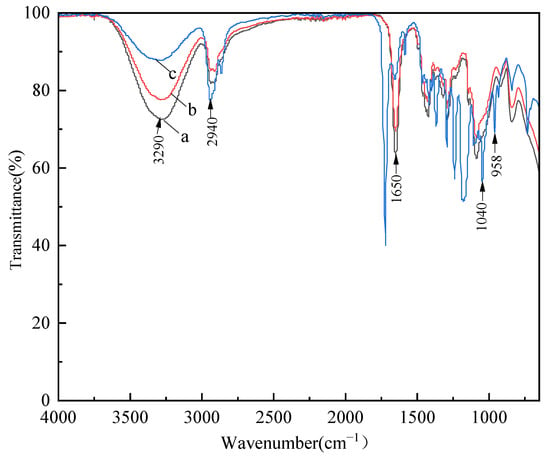
Figure 4.
FTIR spectra of the waterborne polymer coating (a), nanomodified waterborne polymer coating (b), and hydrophobic modified waterborne polymer coating (c).
3.5. Morphological Characterization
Siloxane and nano-SiO2 were employed to enhance the hydrophobicity of the waterborne polymer coatings. SEM analysis confirmed that the surface of the WCU coatings was smooth (Figure 5a), and abundant micropores were observed on the fracture surface of WCU (Figure 5g). Furthermore, the WCA of WCU coating shells was 46.5° (Figure 5a), which may facilitate water/nutrient penetration or water/nutrient release from the coatings shells and then accelerate the N-release rate [32,33]. In comparison, the coating structures of NWCU (Figure 5e,h) and SWCU (Figure 5f,i) were more compact than that of WCU (Figure 5d,g). Furthermore, many hierarchical micro–nanoscale structures were observed on the surface and fracture surface of NWCU (Figure 5b,e) and SWCU (Figure 5c,f), and the WCAs of NWCU and SWCU were 87.2° and 89.3° (Figure 5b,c), respectively, which were 87.53% and 92.04% higher than those for WCU, respectively. Micro–nanoscale structures can help enhance the roughness and hydrophobicity of NWCU and SWCU, thereby improving their water resistance ability and N-release period.
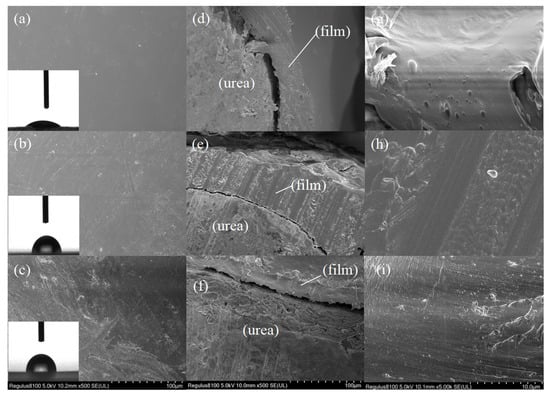
Figure 5.
Surface and fracture surface morphology (500× and 5000×) of WCU (a,d,g), NWCU (b,e,h), and SWCU (c,f,i).
3.6. Thermal Behaviors
The thermal behaviors of the WCU, NWCU, and SWCU coatings were examined via thermogravimetric analysis (TGA) and derivative TGA (DTG) (Figure 6). It can be observed from Figure 6 that the waterborne polymer coatings underwent a three-stage degradation process. The first weight loss stages of the WCU, NWCU, and SWCU coating samples occurred at 25–217 °C, 25–192 °C, and 25–195 °C, respectively, and the weight losses were about 11.84%, 9.31%, and 5.92%, respectively. At this stage, the weight loss was primarily attributed to the evaporation of bound water from the waterborne polymer coatings after heating [34]. The second weight loss stages of WCU, NWCU, and SWCU coating samples occurred at 217–390 °C, 192–394 °C, and 195–459 °C, respectively, which reflect the breaking of the cross-link points and the decomposition of the polymer molecular chains [35].
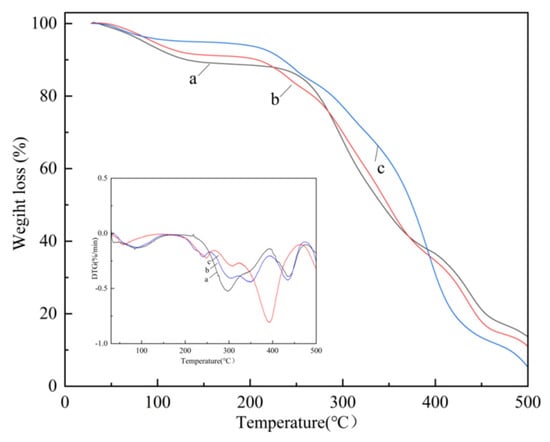
Figure 6.
TGA and DTG curves of WCU (a), NWCU (b), and SWCU (c).
3.7. XPS Spectra
The elemental compositions and chemical valence of the WCU, NWCU, and SWCU coatings were analyzed using XPS analysis, and the results are illustrated in Figure 7 and Figure S1. In the major XPS spectrum of the WCU coating (Figure 7a), 286 and 533 eV correspond to C1s and O1s, evidencing the existence of oxygen and carbon in the waterborne polymer coatings, respectively. After siloxane and nano-SiO2 modification, the XPS spectra for the NWCU and SWCU coatings showed 102 eV, which correspond to Si2p (Figure 7b,c). These results indicate that siloxane and nano-SiO2 were incorporated into the modified waterborne coatings [10,36]. The XPS analysis revealed chemical transformations during the modification process and confirmed the successful modification of the waterborne coatings with siloxane and nano-SiO2.
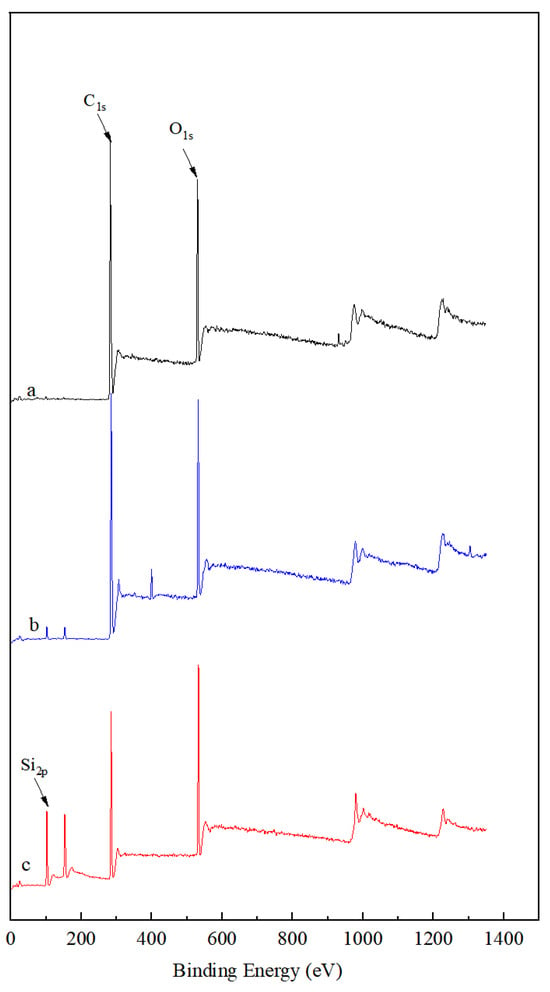
Figure 7.
XPS of WCU (a), NWCU (b), and SWCU (c).
3.8. N-Release Characteristics
The N-release behaviors and kinetics of the WCU are crucial factors for evaluating its potential in agricultural applications [37]. Generally, N-release behaviors are governed by an intricate interplay between the coating material, the aqueous environment, and ionic nutrients, which collectively determine the kinetic pattern of N release [38,39]. The N-release profiles of WCU, NWCU, and SWCU in soil environments with different moisture contents are presented in Figure 8. As presented in Figure 8A, the initial N-release rates of WCU with 40%, 60%, and 80% field capacity in soil were 12.98%, 27.11%, and 37.67%, respectively. During the first five days, the cumulative N-release rate of WCU with 80% field capacity was 93.27%, while those of WCU with 40% and 60% field capacity were 66.09% and 77.8%, respectively. When the incubation time was increased to seven days, almost 95% N of WCU was released. After modification with nano-SiO2 and siloxane, the N-release longevity (80% nitrogen release time) of NWCU and SWCU considerably improved. As shown in Figure 8B, the initial N-release rates for NWCU with 40%, 60%, and 80% field capacity were 8.18%, 12.16%, and 14.06%, respectively, which were 36.94%, 55.15%, and 62.68% lower than those for the corresponding WCU. When the incubation time increased to 21 days, more than 80% N of NWCU was released. As shown in Figure 8C, the initial N-release rates for SWCU with 40%, 60%, and 80% field capacity were 4.13%, 7.7%, and 11.93%, respectively. Furthermore, SWCU with 40%, 60%, and 80% field capacity exhibited improved N-release longevity in approximately 28, 21, and 21 days, respectively. The above results indicate the better N-release properties of the NWCU and SWCU formulations. This outcome could be correlated to the hydrophobic properties of the modified waterborne polymer coating shells, such as the nanoscale rough structure and compact layer structure [10,40].
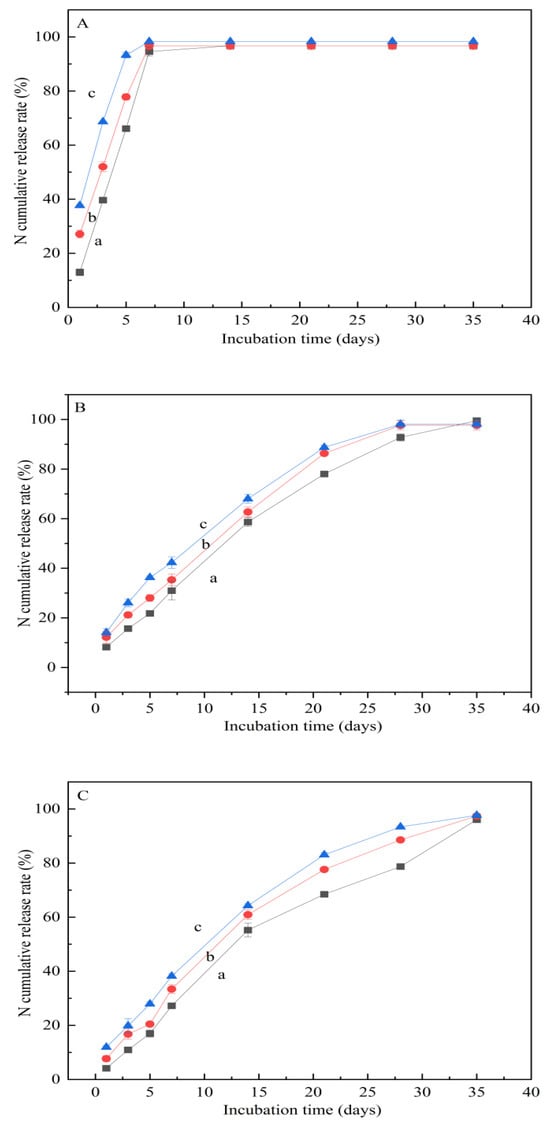
Figure 8.
Cumulative nitrogen-release dynamics of WCU (A), NWCU (B), and SWCU (C). a, b, c represent 40%, 60%, and 80% field capacity, respectively.
To better understand the release mechanism of SWCU in soil, the N-release curve was fitted with the Elovich equation, and simulated parameters are shown in Table 3. The constants “a” and “k” are the maximum N-release rate (%) and the rate constant (d−1), respectively. With the soil moisture content increasing from 40% to 80% field capacity, the “k” of WCU decreased from 0.38 to 0.03 d−1, while those of NWCU and SWCU decreased from 0.24 to 0.09 d−1 and 0.16 to 0.10 d−1, respectively, indicating that as the soil moisture content increases, N-release longevity decreases.

Table 3.
The simulated parameters for nitrogen release of SWCU in soil.
Table 4 exhibits various formulations of controlled-release urea with waterborne coatings. Han et al. [41] indicated that waterborne polymer coatings modified with zeolite can enhance the N-release period of coated urea in soil, with 75.9% N released within 42 days. To enhance the water resistance of waterborne coatings, Azeem et al. [42] modified waterborne coatings with fly ash and reported 88.6% N release after 37 days in soil. Zhang et al. [34] employed waterborne coatings modified with natural rubber. They indicated that 62.7% N was released after 10 days in water. Kaolinite and biochar were also used to modify waterborne coatings, and 19.1% N was released after 29 days [39]. Jungsinyatam et al. [37] indicated that waterborne coatings modified with acrylic acid-co-acrylamide can considerably increase N-release longevity, with 78.3% N released in 30 days. Compared with these previous works, in this study on waterborne polymer coatings modified with nano-SiO2 and siloxane, the WA and porosity significantly decreased (Figure 1 and Figure 2), representing a sustainable and eco-friendly coating candidate for coated urea with enhanced N-release properties.

Table 4.
Comparison of different works on using waterborne polymer coatings to control nutrient release.
4. Conclusions
In summary, the purposes of this research were to explore the potential of an eco-friendly urea coating composed of waterborne polymer materials and assess the influences of siloxane and nano-SiO2 additions on the properties of the hydrophobic modified waterborne polymer materials. The results of this study demonstrate that after modification, WA decreased by 61.33%, and the WCA increased by 92.04%. Moreover, the modified waterborne polymer coating exhibited good mechanical strength. Furthermore, the lower porosity and hierarchical micro–nanoscale structures led to better water repellent capability, and the N-release period increased to 28 days (40% field capacity in soil). Therefore, this novel modification strategy and the modified waterborne polymer coatings fabricated in this study demonstrate the sustainable potential of environmentally friendly coated urea.
Supplementary Materials
The following supporting information can be downloaded at: https://www.mdpi.com/article/10.3390/su17156987/s1, Figure S1: XPS spectra of WCU (a), NWCU (b) and SWCU (c) in C1S, O1S and Si 2p.
Author Contributions
Conceptualization, S.C. and J.Z.; methodology, S.C.; validation, F.L. and X.L.; formal analysis, S.C. and F.L.; investigation, F.L. and X.L.; resources, S.C., J.W. and J.Z.; data curation, S.C. and F.L.; writing—original draft preparation, S.C. and F.L.; writing—review and editing, S.C., J.Z. and W.Z.; visualization, S.C. and F.L.; supervision, J.W.; project administration, S.C. and J.Z.; funding acquisition, S.C. and J.Z. All authors have read and agreed to the published version of the manuscript.
Funding
This research was funded by the Scientific Research Key Project of Anhui Provincial Department of Education, grant number 2024AH050291, the Scientific Research Foundation of Anhui Science and Technology University, grant number ZHYJ202202 and the Scientific Research Key Project of Anhui Provincial Department of Education, grant number 2022AH051619. And The APC was funded by the Scientific Research Key Project of Anhui Provincial Department of Education (2024AH050291).
Institutional Review Board Statement
Not applicable.
Informed Consent Statement
Not applicable.
Data Availability Statement
Data will be made available upon request.
Conflicts of Interest
The authors declare no competing financial interest or personal relationships that could influence this work.
References
- Dong, S.Q.; Pang, M.H.; Li, H.T.; Zou, G.Y.; Liang, L.N. Introduction of bio-based hard segment as an alternative strategy to environmentally friendly polyurethane coated urea. Ind. Crops Prod. 2023, 203, 117164. [Google Scholar] [CrossRef]
- Zhao, C.H.; Tian, H.Y.; Zhang, Q.; Liu, Z.G.; Wang, J. Preparation of urea-containing starch-castor oil superabsorbent polyurethane coated urea and investigation of controlled nitrogen release. Carbohydr. Polym. 2021, 253, 117240. [Google Scholar] [CrossRef] [PubMed]
- Daniel, A.I.; Adewale, O.F.; Arun, G.; Olalekan, O.B.; Omolola, A.; Stacey, F.; Adam, F.B.; Vuyo, M.; Marshall, K.; Ashwil, K. Biofertilizer: The future of food security and food safety. Microorganisms 2022, 10, 1220. [Google Scholar] [CrossRef]
- Tang, J.; Xu, J.; Fan, H.; Li, R.; Shi, M.; Liu, Y.; Wang, B.; Liu, P. Preparation of hydroxy-terminated polydimethylsiloxane and nano-SiO2 hydrophobic polyurethane coated urea and investigation of controlled nitrogen release. Chem. Eng. Sci. 2025, 302, 120728. [Google Scholar] [CrossRef]
- Pang, M.H.; Liu, Z.R.; Li, H.Y.; Liang, L.N.; Li, X.; Li, L.X. Effect of fatty acids on vegetable-oil-derived sustainable polyurethane coatings for controlled-release fertilizer. Coatings 2024, 14, 1183. [Google Scholar] [CrossRef]
- Zhao, C.X.; Liu, J.N.; Li, B.Y.; Ren, D.; Chen, X.; Yu, J.; Qi, Z. Multiscale construction of bifunctional electrocatalysts for long-lifespan rechargeable zinc–air batteries. Adv. Funct. Mater. 2020, 36, 2003619. [Google Scholar] [CrossRef]
- Wang, Q.; Dong, F.P.; Dai, J.; Zhang, Q.P.; Jiang, M.; Xiong, Y.Z. Recycled-oil-based polyurethane modified with organic silicone for controllable release of coated fertilizer. Polymers 2019, 11, 454. [Google Scholar] [CrossRef]
- Lu, P.F.; Zhang, M.; Li, Q.; Xu, Y. Structure and properties of controlled release fertilizers coated with thermosetting Resin. Polym.-Plast. Technol. Eng. 2013, 52, 381–386. [Google Scholar] [CrossRef]
- Yang, X.D.; Jiang, R.F.; Lin, Y.Z.; Li, Y.T.; Li, J.; Zhao, B.Q. Nitrogen release characteristics of polyethylene-coated controlled-release fertilizers and their dependence on membrane pore structure. Particuology 2018, 36, 158–164. [Google Scholar] [CrossRef]
- Ma, X.X.; Chen, J.Q.; Yang, Y.C.; Su, X.R.; Zhang, S.G. Siloxane and polyether dual modification improves hydrophobicity and interpenetrating polymer network of bio-polymer for coated fertilizers with enhanced slow release characteristics. Chem. Eng. J. 2018, 350, 1125–1134. [Google Scholar] [CrossRef]
- Kassem, I.; Ablouh, E.H.; Bouchtaoui, F.Z.E.; Mohamed, J.; Mounir, E.A. Polymer coated slow/controlled release granular fertilizers: Fundamentals and research trends. Prog. Mater. Sci. 2024, 144, 101269. [Google Scholar] [CrossRef]
- Elhassani, C.E.; Abdelouahed, E.G.; Younes, E.; Salma, E.; Karim, D.; Soumia, A.; Mohamed, Z. Lignin nanoparticles filled chitosan/polyvinyl alcohol polymer blend as a coating material of urea with a slow-release property. J. Appl. Polym. Sci. 2023, 140, e53755. [Google Scholar] [CrossRef]
- Ibrahim, K.A.; Naz, M.Y.; Shukrullah, S.; Sulaiman, S.; Abdul, G.; Abdel-Salam, N.M. Nitrogen pollution impact and remediation through low cost starch based biodegradable polymers. Sci. Rep. 2020, 10, 5927. [Google Scholar] [CrossRef]
- Ranjith, R.; Balraj, S.; Ganesh, J.; Milton, M.C.J. Therapeutic agents loaded chitosan-based nanofibrous mats as potential wound dressings: A review. Mater. Today Chem. 2019, 12, 386–395. [Google Scholar] [CrossRef]
- Bakshia, P.; Selvakumara, D.; Kadirvelub, K.; Kumar, N.S. Chitosan as an environment friendly biomaterial-a review on recent modifications and applications. Int. J. Biol. Macromol. 2019, 150, 1072–1083. [Google Scholar] [CrossRef]
- Kabiri, S.; Andelkovic, R.D.; Silva, D.; Fien, D.; Roslyn, B.; Tavakkoli, E.; Losic, D.; Mclaughlin, M. Engineered phosphate fertilizers with dual-release properties. Ind. Eng. Chem. Res. 2020, 59, 5512–5524. [Google Scholar] [CrossRef]
- Aslam, M.; Mazhar, A.K.; Zulfiqar, A.R. Investigation of structural and thermal properties of distinct nanofillers-doped PVA composite films. J. Polym. Bull. 2018, 76, 73–86. [Google Scholar] [CrossRef]
- Das, P.; Ray, S.K.; Kuila, S.B.; Samant, H.S.; Singha, N.R. Systematic choice of crosslinker and filler for pervaporation membrane: A case study with dehydration of isopropyl alcohol–water mixtures by polyvinyl alcohol membranes. Sep. Purif. Technol. 2011, 81, 159–173. [Google Scholar] [CrossRef]
- Liu, Y.; Cao, L.; Wang, L.; Qi, Y.; Zhao, Y.; Lu, H.; Lu, L.; Zhang, D.; Wang, Z.; Zhang, H. Preparation and application of degradable lignin/poly (Vinyl Alcohol) polymers as urea slow-release coating materials. Molecules 2024, 29, 1699. [Google Scholar] [CrossRef] [PubMed]
- Boinovich, L.B.; Alexandre, M.E.; Alexander, D.M.; Alexandr, G.D.; Kirill, A.E. Synergistic effect of superhydrophobicity and oxidized layers on corrosion resistance of aluminum alloy surface textured by nanosecond laser treatment. ACS Appl. Mater. Emelyanenko Interfaces 2015, 7, 19500–19508. [Google Scholar] [CrossRef]
- Wang, R.; Jie, Z.; Meng, K.X.; Wang, H.; Deng, T.; Gao, X.F.; Jiang, L. Bio-inspired superhydrophobic closely packed aligned nanoneedle architectures for enhancing condensation heat transfer. Adv. Funct. Mater. 2018, 28, 1800634. [Google Scholar] [CrossRef]
- Xie, J.Z.; Yang, Y.C.; Gao, B.; Wan, Y.S.; Li, Y.C.; Xu, J.; Zhao, Q.H. Biomimetic superhydrophobic biobased polyurethane-coated fertilizer with atmosphere “Outerwear”. ACS Appl. Mater. Interfaces 2017, 9, 15868–15879. [Google Scholar] [CrossRef]
- Chen, S.L.; Han, Y.Y.; Yang, M.; Zhu, X.Q.; Liu, C.T.; Liu, H.D.; Zou, H.T. Hydrophobically modified water-based polymer for slow-release urea formulation. Prog. Org. Coat. 2020, 149, 105964. [Google Scholar] [CrossRef]
- Shen, Y.Z.; Du, C.W.; Zhou, J.M.; Ma, F. The facile modification of polyacrylate emulsion via hexadecane to enhance controlled-release profiles of coated urea. Sci. Rep. 2018, 8, 12279. [Google Scholar] [CrossRef] [PubMed]
- Xing, Y.D.; Li, X.W.; Xu, J.B.; Zhang, F.A. Organosilicon-modified double crosslinked waterborne polyurethane coatings. Prog. Org. Coat. 2024, 190, 108372. [Google Scholar] [CrossRef]
- Xiong, M.N.; Bo, Y.; Zhou, S.X.; Wu, L.M. Study on acrylic resin/titania organic–inorganic hybrid materials prepared by the sol–gel process. Polymer 2004, 45, 2967–2976. [Google Scholar] [CrossRef]
- Dural, S.; Şebnem, S.C.; Nilhan, K.A. Improving the mechanical, thermal and surface properties of polyaspartic ester bio-based polyurea coatings by incorporating silica and titania. Mater. Today Commun. 2024, 38, 107654. [Google Scholar] [CrossRef]
- Feng, Y.H.; Wei, X.; Huang, J.; Zhang, P. Thermo-optic response and mechanical properties of hybrid polyurethane elastomers via silicon group-induced microphase separation evolution. React. Funct. Polym. 2023, 193, 105739. [Google Scholar] [CrossRef]
- Tanan, W.; Panichpakdee, J.; Suwanakood, P.; Saengsuwan, S. Biodegradable hydrogels of cassava starch-g-polyacrylic acid/natural rubber/polyvinyl alcohol as environmentally friendly and highly efficient coating material for slow-release urea fertilizers. J. Ind. Eng. Chem. 2021, 101, 237–252. [Google Scholar] [CrossRef]
- Santos, A.M.P.; Alexandre, C.B.; Ana, C.C.P.B.; Raphael, A.B.G.; Jerusa, S.G.; Marcello, G.T. New organomineral complex from humic substances extracted from poultry wastes: Synthesis, characterization and controlled Release Study. J. Braz. Chem. Soc. 2018, 29, 140–150. [Google Scholar] [CrossRef]
- Zhao, X.; Ma, F.; Yan, L.; Liu, J.; Zhang, T.H.; Su, X.H.; Wang, W.T.; Yang, Y.C.; Xu, J.; Xie, J.Z. Double-modified biopolymer-coatings based on recyclable poplar-catkin: Efficient performance, controlled-release mechanism and rice application. Prog. Org. Coat. 2024, 186, 107980. [Google Scholar] [CrossRef]
- Yang, M.; Gao, H.; Zou, H.T.; Sun, D. Siloxane and lauric acid copper dual modification improves hydrophobicity and elasticity of all biopolymer coated fertilizers with enhanced nitrogen release abilities. Ind. Crops Prod. 2025, 226, 120620. [Google Scholar] [CrossRef]
- Chen, S.L.; Yang, M.; Han, Y.Y.; Liu, H.D.; Zou, H.T. Hydrophobically modified sustainable bio-based polyurethane for controllable release of coated urea. Eur. Polym. J. 2020, 142, 110114. [Google Scholar] [CrossRef]
- Zhang, M.; Yuan, Y.; Jin, J.; Sun, J.; Tian, X. Polyvinyl alcohol composite hydrogels/epoxidized natural rubber composites (CMCS/PVA/CS-ENR) with core-shell structure as biomass coating material for slow-release nitrogen fertilizer. Prog. Org. Coat. 2023, 183, 107744. [Google Scholar] [CrossRef]
- Chen, X.; Chen, C.T.; Zhang, H.; Huang, Y.; Yang, J.Z.; Sun, D.P. Facile approach to the fabrication of 3D cellulose nanofibrils (CNFs) reinforced poly(vinyl alcohol) hydrogel with ideal biocompatibility. Carbohydr. Polym. 2017, 173, 547–555. [Google Scholar] [CrossRef]
- Zhao, J.R.; Li, X.L.; Liu, F.X.; Zhao, W.Y.; Chen, S.L. Smart fertilizer with temperature-responsive behavior coated using a naturally derived material. J. Appl. Polym. Sci. 2025, 142, 56721. [Google Scholar] [CrossRef]
- Jungsinyatam, P.; Pitchayaporn, S.; Sayant, S. Multicomponent biodegradable hydrogels based on natural biopolymers as environmentally coating membrane for slow-release fertilizers: Effect of crosslinker type. Sci. Total Environ. 2022, 843, 157050. [Google Scholar] [CrossRef]
- Salimi, M.; Channab, B.E.; Ayoub, E.I.; Mohamed, Z.; Elaheh, M. A comprehensive review on starch: Structure, modification, and applications in slow/controlled-release fertilizers in agriculture. Carbohydr. Polym. 2023, 322, 121326. [Google Scholar] [CrossRef]
- Zhao, X.; Lu, J.W.; Jiang, S.M.; Fu, C.; Li, Y.F.; Xiang, H.; Lu, R.H.; Zhu, J.; Yu, B. Enhancing slow-release performance of biochar-based fertilizers with kaolinite-infused polyvinyl alcohol/starch coating: From fertilizer development to field application. Int. J. Biol. Macromol. 2025, 302, 140665. [Google Scholar] [CrossRef]
- Assimi, T.E.; Omar, L.; Abdellatif, E.M.; Mehdi, K.; Abdelmalek, D.; Redouane, B.; Rachid, B.; Mustapha, R.; Mohammed, L. Sustainable coating material based on chitosan-clay composite and Paraffin wax for Slow-Release DAP Fertilizer. Int. J. Biol. Macromol. 2020, 161, 492–502. [Google Scholar] [CrossRef]
- Han, Y.Y.; Chen, S.L.; Xie, B.Y.; Wang, Y.Q.; Fan, Y.W.; Meng, Q.Y.; Zou, H.T.; Zhang, Y.L. Waterborne polymer modified with zeolite for environment-friendly slow-release coated urea. J. Appl. Polym. Sci. 2023, 140, e53633. [Google Scholar] [CrossRef]
- Azeem, B.; Kuzilati, K.; Muhammad, N.; Lau, K.K.; Mohammed, K.A.; Zakaria, A.Q.; Salman, R.N.; Noureddine, E. Production and Characterization of Controlled Release Urea Using Biopolymer and Geopolymer as Coating Materials. Polymers 2020, 12, 400. [Google Scholar] [CrossRef] [PubMed]
Disclaimer/Publisher’s Note: The statements, opinions and data contained in all publications are solely those of the individual author(s) and contributor(s) and not of MDPI and/or the editor(s). MDPI and/or the editor(s) disclaim responsibility for any injury to people or property resulting from any ideas, methods, instructions or products referred to in the content. |
© 2025 by the authors. Licensee MDPI, Basel, Switzerland. This article is an open access article distributed under the terms and conditions of the Creative Commons Attribution (CC BY) license (https://creativecommons.org/licenses/by/4.0/).